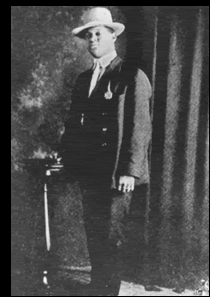
Case in point seems to be Freddie Keppard. A legend in New Orleans at the beginning of the century, he seems to have taken the baton from Buddy Bolden and taken jazz to the next level. A suspicious man, it is said that he took to playing with a handkerchief over his hand so no one could see his fingering on the cornet. Such was his suspicious nature that he declined to make a recording of his music when the Victrola Company asked him to as far back as 1915. It seems he was afraid of the competition listening to his music and eventually bettering him. So was passed up the opportunity to have the very first jazz recording.
There doesn't seem to be many recordings around where Keppard is definitely contributing. The Red Hot Jazz website lists Salty Dog and Stockyard Strut as two songs that he definitely played on. The latter borrows heavily from the chord structure of Tiger Rag but shows Keppard's improvisational skills to the fullest. The recordings are very dated and the boundaries between rag time and "hot" jazz seemed blurred. However you can see the direction that the music is taking.
Keppard is also a good example of someone who instigated the move away from New Orleans and spreading jazz across the country. After moving to the east coast he eventually settled in Chicago.
No comments:
Post a Comment